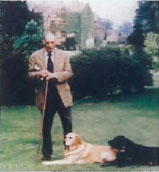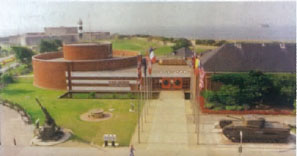
[caption id="TheDDayMuseumandOverlordEmbroidery_img1" align="aligncenter" width="762"]

[caption id="TheDDayMuseumandOverlordEmbroidery_img2" align="aligncenter" width="159"]

[caption id="TheDDayMuseumandOverlordEmbroidery_img3" align="aligncenter" width="751"]

D-DAY MUSEUM AND OVERLORD EMBROIDERY
[caption id="TheDDayMuseumandOverlordEmbroidery_img4" align="aligncenter" width="297"]

SOMETIME DURING THE TWO decades following the Battle of Hastings, an unknown group of artisans recorded William of Normandy’s conquest of England on an exquisitely detailed embroidery known as the Bayeux Tapestry. The historic narrative unfolds through more than 1,400 figures, including 623 humans, 202 horses, and 41 ships, along with some 2,000 words stitched in wool across 230 feet of linen. The medieval masterpiece stood unrivaled as a story-telling embroidery for nine centuries—then along came Lord Dulverton.
Inspired by the beautiful Bayeux Tapestry, in 1968 Lord Dulverton of Batsford commissioned artist Sandra Lawrence to design an embroidery depicting the 1944 Allied invasion of Normandy. The English Channel has seen some impressive invasion fleets—the Romans in AD 43, the Normans in 1066, and the Spanish in 1588—but none compare to World War II’s Normandy Invasion, otherwise known as Operation Overlord. On D-Day, 6th June 1944, approximately 156,000 Allied troops landed on France’s Normandy shores, while 11,590 aircraft and 6,939 sea vessels patrolled the air and waves. Six days later the numbers of landed Allies had swollen to 326,547 troops, 54,186 vehicles, and 104,428 tons of supplies. By 25th August, the invasion force had successfully pushed inland and liberated Paris.
To tell this epic story Lawrence painted 34 scenes showing the invasion from the planning stages in 1940 to victory in August 1944. The paintings were transferred onto linen using “pricking and pouncing,” a technique that dates back to Tudor England. The linen then went to the Royal School of Needlework where 20 needlewomen set to work. Not a strict, stitched-only embroidery, such as the Bayeux Tapestry, the 272-foot-long Overlord Embroidery features appliques of more than 50 fabrics, including Navy, Army, and Air Force uniforms. The needlework took five years to complete and depicts some complicated scenes, including portraits of King George VI, Winston Churchill, Field Marshal Bernard Montgomery, General Dwight Eisenhower, and Vice Admiral Mountbatten.
MUSEUM NOTES
D-Day Museum and Overlord Embroidery, Clarence Esplanade, Southsea, Hants
Tel: 02392 827261
Web: www.ddaymuseum.co.uk and www.d-day60.co.uk
Email: [email protected]
Admission: £5 for adults, £3.75 for seniors, £3 for children and students.
Hours: daily Apr-Oct 10 am-5.30 pm and Nov-Mar 10 am-5 pm. Closed 24-26 Dec.
The D-Day Museum in Portsmouth opened in 1984 to house the Overlord Embroidery, displayed in the museum’s main gallery. Visitors can rent soundguides available in four languages that give detailed descriptions of each of the linen’s 34 panels. At panel 17 the soundguide includes pipe music played by Bill Millin, who served as the personal piper to Lord Lovat, commander of the 1st Special Service Brigade at Normandy. A theater in the gallery provides historical context and atmosphere for the Embroidery with archive film footage, wartime photographs, period music, and the taped memories of D-Day veterans.
The museum’s remaining galleries feature tanks, jeeps, scout cars, anti-aircraft guns, and military equipment in reconstructions of wartime scenes, including an air warden’s living room during the Blitz, a Map Room with officers planning Operation Overlord, an Anderson Shelter, and a German pillbox. In the Beach Landing gallery visitors can board an actual landing craft from D-Day while watching archive film footage of the Normandy Invasion. This year the museum will mark the 60th anniversary of Operation Overlord with a number of special events, including an exhibit from mid-May through October that commemorates the contributions Portsmouth’s civilians made to the preparations for D-Day.
In a speech given in 1978 at the Embroidery’s London unveiling, Lord Dulverton said, “The Embroidery is a tribute to our Country and Countrymen over the part played in defeating a great evil that sprang upon the Western World. It is not, and was never intended to be, a tribute to war, but to our people in whom it brought out in adversity so much that is good, determination, ingenuity, fortitude and sacrifice. It focuses upon one historic and explicitly important campaign, to which the world conflict had led and made possible; and the Bayeux Tapestry nearly 900 years before D-Day certainly beckoned it to be made.”
As an officer in the Lovat Scouts during the war, Lord Dulverton oversaw a Fieldcraft, Observation, and Sniping School to train officers preparing for D-Day and the Battle of Normandy. Many of those young men failed to return from battle, giving the ultimate sacrifice for their country. “If, in the years ahead, I can bring home to succeeding generations the message of sacrifice and selflessness displayed by those who took part in Overlord, [the Overlord Embroidery] will have achieved more than I could ever [have] dared for. We, with all our troubles that beset our world, lead our lives for good or ill with freedom still to make some degree of choice. We tend to forget that this freedom would not be with us still, had evil triumphed in those days.”
Thanks for the reminder, Lord Dulverton.
ALLYSON PATTON is the former picture researcher at BRITISH HERITAGE.





Comments